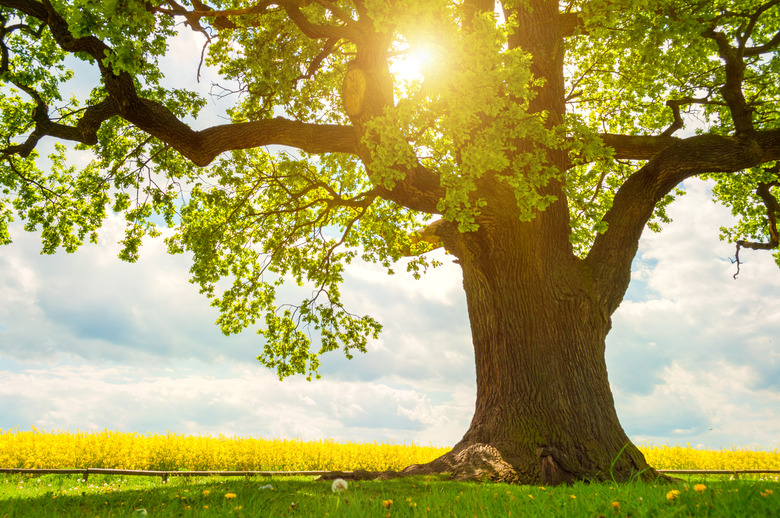Native Oak Trees Of Louisiana
Oak trees of different species grow native in Louisiana, from the fertile bottomlands and wetlands to the drier uplands of slightly higher elevations. The oaks in Louisiana include some categorized as evergreen oaks, which retain their green appearance year round. Other Louisiana oaks are what botanists term chestnut oaks, due to the leaves close likeness to that of the chestnut trees. Still others Louisiana oaks ocur close to water, thriving near on the banks of rivers and streams.
Swamp Chestnut Oak
Swamp Chestnut Oak
The swamp chestnut oak (Quercus michauxii) has two nicknames in Louisiana. One is cow oak, since cows readily consume the acorns, which are also edible for humans. The other is basket oak, since fibers from the bark and wood went into forming baskets that laborers used to carry cotton. Swamp chestnut oak grows in the forests of the Louisiana bottomlands on damp areas that possess well-draining sandy loam. The tree grows around 60 to 70 feet tall under such conditions and has leaves that are as long as 9 inches. The oval leaves are at their widest point slightly past their middles and have the same wavy teeth along their edges that chestnut tree leaves do. Swamp chestnut oak has a very high quality wood, making it a valuable timber tree. The acorns occur on long stems, up to 4 inches in length and are sweet tasting; they are flavorful enough to consume without boiling says the "National Audubon Society Field Guide to Trees."
Laurel Oak
Laurel Oak
Laurel oak (Quercus laurifolia) is one of the semi-evergreen species of oaks, keeping the leaves through spring of the following year, at which time new ones quickly grow in and replace the old ones. The tree grows in upland locations to elevations of about 500 feet and along streams and rivers in the Deep South. The laurel oak's leaves are between 3 and 4 inches long, elliptical, with a leathery feel, and smooth shiny green surfaces. The acorns typically grow by themselves, occasionally in twos, and are only half an inch long. These acorns require two full growing seasons to mature. The laurel oak is of little economic importance in terms of its wood, but is a widely used shade tree throughout many areas of the South. In the wild, laurel oak commonly exists alongside loblolly pine, live oak and sweetgum trees.
Water Oak
Water Oak
The water oak (Quercus nigra) is one of the more short-lived kinds of oaks, with most having an expected lifespan of from 60 to 80 years. Water oak grows throughout Louisiana except for along the coastal sections. Water oak serves as a landscaping tree and the heavy wood makes excellent fuel. The water oak is a thin tree that averages between 50 and 80 feet tall with a symmetrical rounded crown of branches. The water oak's leaves have the shape of a spatula, possessing a narrow base but a broad top. The leaves fall off the tree late in the autumn, sometimes as late as early winter, turning yellow before doing so. Water oak is a common tree growing nearby to waterways in the South, but it can also survive on much drier upland ground, states the United States Forest Service website.
References
- University of Florida Institute of Food and Agricultural Sciences: Forest Trees
- United States Forest Service: Water Oak
- "Trees of North America"; C. Frank Brockman; 1996
- "National Audubon Society Field Guide to Trees"; Elbert L. Little; 2008
Cite This Article
MLA
Lindell, John. "Native Oak Trees Of Louisiana" sciencing.com, https://www.sciencing.com/native-oak-trees-louisiana-6521660/. 22 November 2019.
APA
Lindell, John. (2019, November 22). Native Oak Trees Of Louisiana. sciencing.com. Retrieved from https://www.sciencing.com/native-oak-trees-louisiana-6521660/
Chicago
Lindell, John. Native Oak Trees Of Louisiana last modified March 24, 2022. https://www.sciencing.com/native-oak-trees-louisiana-6521660/
